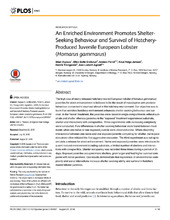An enriched environment promotes shelter-seeking behaviour and survival of hatchery-produced juvenile European lobster (Homarus gammarus)
Aspaas, Stian; Grefsrud, Ellen Sofie; Fernø, Anders; Jensen, Knut Helge; Trengereid, Henrik; Agnalt, Ann-Lisbeth
Peer reviewed, Journal article
Published version

View/
Date
2016-08-25Metadata
Show full item recordCollections
Original version
https://doi.org/10.1371/journal.pone.0159807Abstract
The high loss of newly released hatchery-reared European lobster (Homarus gammarus) juveniles for stock enhancement is believed to be the result of maladaptive anti-predator behaviour connected to deprived stimuli in the hatchery environment. Our objective was to learn if an enriched hatchery environment enhances shelter-seeking behaviour and survival. In the “naïve” treatment, the juveniles were raised in single compartments without substrate and shelter whereas juveniles in the “exposed” treatment experienced substrate, shelter and interactions with conspecifics. Three experiments with increasing complexity were conducted. Few differences in shelter-seeking behaviour were found between treatments when one naïve or one exposed juvenile were observed alone. When observing interactions between one naïve and one exposed juvenile competing for shelter, naïve juveniles more often initiated the first aggressive encounter. The third experiment was set up to simulate a release for stock enhancement. Naïve and exposed juveniles were introduced to a semi-natural environment including substrate, a limited number of shelters and interactions with conspecifics. Shelter occupancy was recorded three times during a period of 35 days. Exposed juveniles occupied more shelters, grew larger and had higher survival compared with naïve juveniles. Our results demonstrate that experience of environmental complexity and social interactions increase shelter-seeking ability and survival in hatchery reared lobster juveniles.
